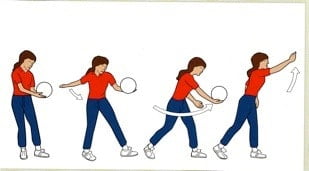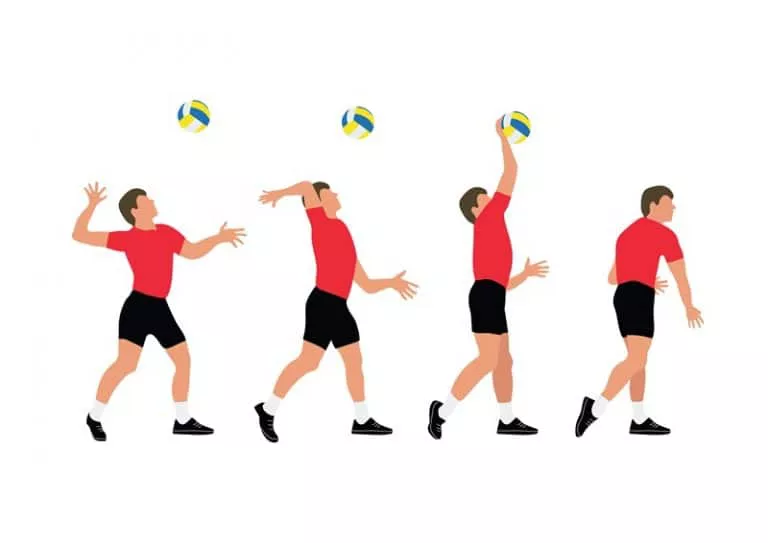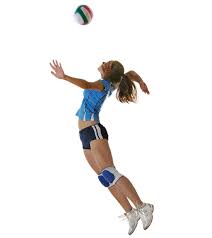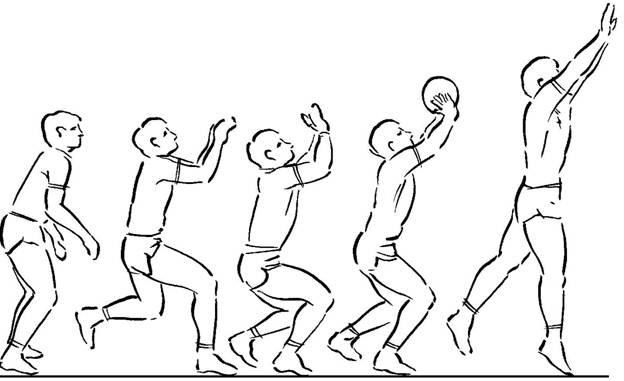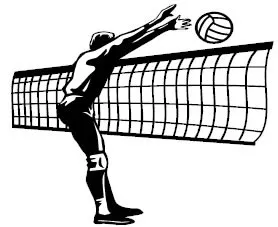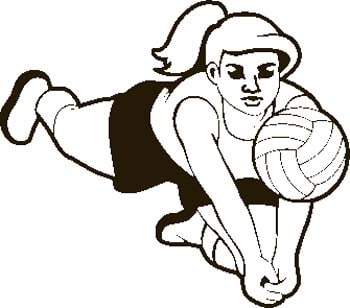Volleyball Rules and Techniques
Learn about Volleyball Rules and Techniques. The main rules and main techniques of Volleyball.
01- What is the Volleyball Court size?
The volleyball court is a rectangle and is 18 meters (59 feet) long and 9 meters (29.5 feet) wide.
The lines on the court are 5 centimeters (2 inches) wide.
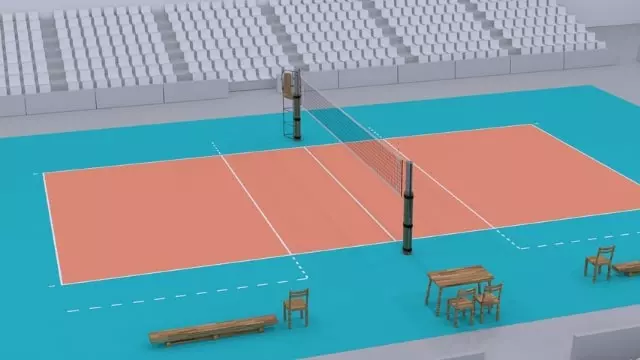
02 – What is the Volleyball net height?
-
The height of the women’s volleyball net is 2.24 meters (7.35 feet) and the height of the men’s volleyball net is 2.43 meters (7.97 feet).
-
The posts are 2.55 m (8.35 ft) high and are placed 0.5 m (1.7 ft) to 1 m (3.3 ft) outside the sidelines of the court.
-
The volleyball net is 1 meter (3.3 feet) wide and 9.50 meters (31.2 feet) to 10 meters (32.8 feet) long.
03 – How many players are there in a Volleyball team?
A complete Volleyball team has 12 players, with 6 players on court.
How many sets are there in a Volleyball match?
-
A volleyball match has a minimum of 3 sets and a maximum of 5 sets.
-
The team which first scores 25 points, with a difference of 2 points with respect to the other team, wins a set.
-
If the game is tied at 24-24, the set will continue beyond 25 points, until one of the teams builds a two-point lead over the other and wins the set.
-
The team who first wins 3 sets, wins the match.
-
In the event of a tie at 2 sets each team, a 15-point tiebreak set is played.
-
The team that first scores 15 points, with a two-point lead over the opposing team, wins both the tiebreak set and the match.
04 – Positions and Rotation in Volleyball
-
Three players must be positioned in the Attack Zone or Front Zone, position 4 (at the left side of the net), position 3 (at the center of the net), position 2 (at the right side of the net).
-
And three players must occupy the Back Zone of the court: position 5 (at the left side of the backcourt), position 6 (at the center of the backcourt) and position 1 (at the right side of the backcourt).
Rotation in Volleyball
The order of rotation in Volleyball is defined by the team’s starting line-up in each set.
When the team that is RECEIVING the Serve wins the Rally, it gains the right to serve, and its players must rotate one position clockwise.
The player that was in position 2 goes to position 1, the player that was in position 1 goes to position 6, the player that was in position 6 goes to position 5, and so forth, until all of the players have advanced one position clockwise.
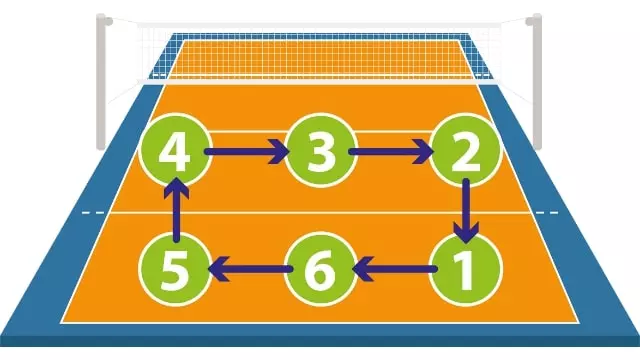
Important note! The player that occupied position 2 and advanced to position 1 will, necessarily, be responsible for the Serve that follows.
05 – Hits by the Team
A team may touch the ball up to 3 times before sending it back to the opposing team. At blocking, the touch does not count as a touch by the team..
06 – Double Contact Fault in Volleyball
A player may not hit the ball twice in succession. At blocking, the touch does not count as the first touch by the player.
07 – Ball Carrying or Extended Contact in Volleyball
It is not allowed to push or throw the ball, it must be rebound or hit.
08 – Penetration above the Net in Volleyball
Only during the action of blocking it is permitted to penetrate into the opponent’s court above the net.
09 – Penetration under the net in Volleyball
It is permitted to penetrate into the opponent’s court under the net in the following situations:
-
without interfering in the opponent’s play;
-
maintaining part of the feet on or above the central line of the court.
10 – Contact with the Volleyball net
-
Contact with the net by a player, between the antennae, is always considered a fault, if it occurs during a playing action.
-
When the ball touches the net and causes it to touch a player, it is not considered a fault.
-
Touching the posts, the ropes that hold the net or the net itself is not considered a fault if it is done outside the limits of the antennae.
VOLLEYBALL TECHNIQUES
WHAT ARE VOLLEYBALL TECHNIQUES?
The Techniques are the skills used by players in the game of Volleyball. The main Fundamentals are the Service, Reception or Pass, Setting, Attack, Block and Defense.
THE SERVICE IN VOLLEYBALL
The service is one of the main fundamentals, is the act of putting the ball into play. In the language of Volleyball, the service is the foundation that starts a Rally. A well-executed service is one that makes it difficult for the opposing team to receive (pass), will make the players of the receiving team have to move away from their positions and have more difficulty to perform an attack.
“Volleyball Rally is all the actions that happen in the game from the moment a service is made until the moment a team scores a point. With each new service, a new Rally starts. ”
By the FIVB Volleyball Rules, the serving player must be behind the end line of his court, a region called service zone.
Related Service Rules
“The Volleyball service zone is a 9-meter wide area behind the end line on either side of the court.”
TYPES OF SERVICE
There are three types or styles of Volleyball service: Under Service, Float Service, and Jump Service.
THE UNDER SERVICE
It is a slower type of service in which the ball travels higher over the net. It is the most suitable service for beginners in Volleyball.
PERFORMING THE UNDER SERVICE
If you are right-handed, hold the ball with your left hand at your waist, with your right hand closed, your thumb out, hit the bottom of the ball hard enough that it overtakes the net and falls into the adversary court. If you are left-handed, just do the same movement, switching the hands.
FLOAT SERVICE
The Float Service is faster and more efficient, used also for professional players.
PERFORMING THE FLOAT SERVICE
Hold the ball with one or both hands, toss it over the head and hit the ball with the palm of your hand.
JUMP SERVICE
The Jump Service is very fast and efficient, the most commonly used among professional players.
PERFORMING THE JUMP SERVICE
The player should be a few steps away from the end line, toss the ball high and forward, run, jump and hit the ball with the palm of the hand, as high and strong as possible.
RECEPTION IN VOLLEYBALL
The Reception is one of the Volleyball Basics Fundamentals, it is the act of receiving the opposing service and passing the ball to the team setter. The reception is the first of three contacts allowed for each team.
The most used technique in the reception is the dig (see image above). It is important during the dig execution, that the ball has contact with both forearms.
SETTING IN VOLLEYBALL
The setting is usually the second contact of the three rings allowed for each team. The most commonly used technique for performing is the set. However, the setting can also be done with a dig.
The goal of the setting is to raise the ball near the net for a teammate to perform an attack.
Related Setting Rules
“If the Libero is in the front zone and makes a setting using both hands (sett), his teammates cannot attack the ball above the upper edge of the net.”
ATTACK IN VOLLEYBALL
The attack is most often the third contact with the ball, allowed to each team. The most used technique in the attack is a sequence of running approach, jump and hit the ball with one hand. Usually, the attack is done by bouncing and hitting the ball with the palm as hard as possible and downwards.
TIP
The tip is a type of non-force attack when a player jumps to perform an attack and instead of making a strong hit, he controls the ball with his fingertips to deflect the opposing block.
BLOCK IN VOLLEYBALL
The Block (see image) is a defensive action that aims to block the attack and send the ball back to the opposing court.
The block can be single (one player), double (two players) or triple (three players).
Related Block Rules
“Is not allowed to block the adversary service”
“The libero cannot block or attempt to block”
DEFENSE IN VOLLEYBALL
The defense is a fundamental that can be performed with any part of the body, including the feet. The goal of the defense is to prevent the success of the attack of the opposing team.
The defense is such an important fundamental in Volleyball that there is an expert defensive player, the libero.
